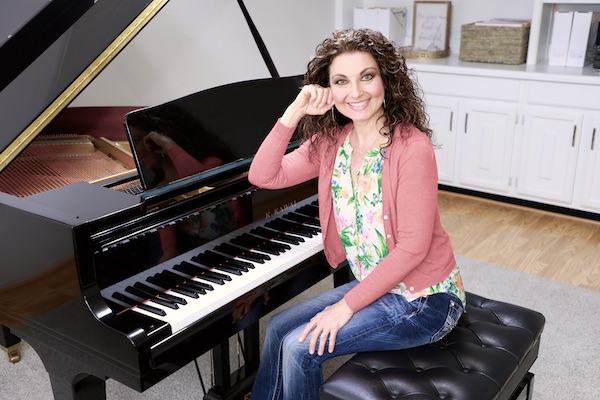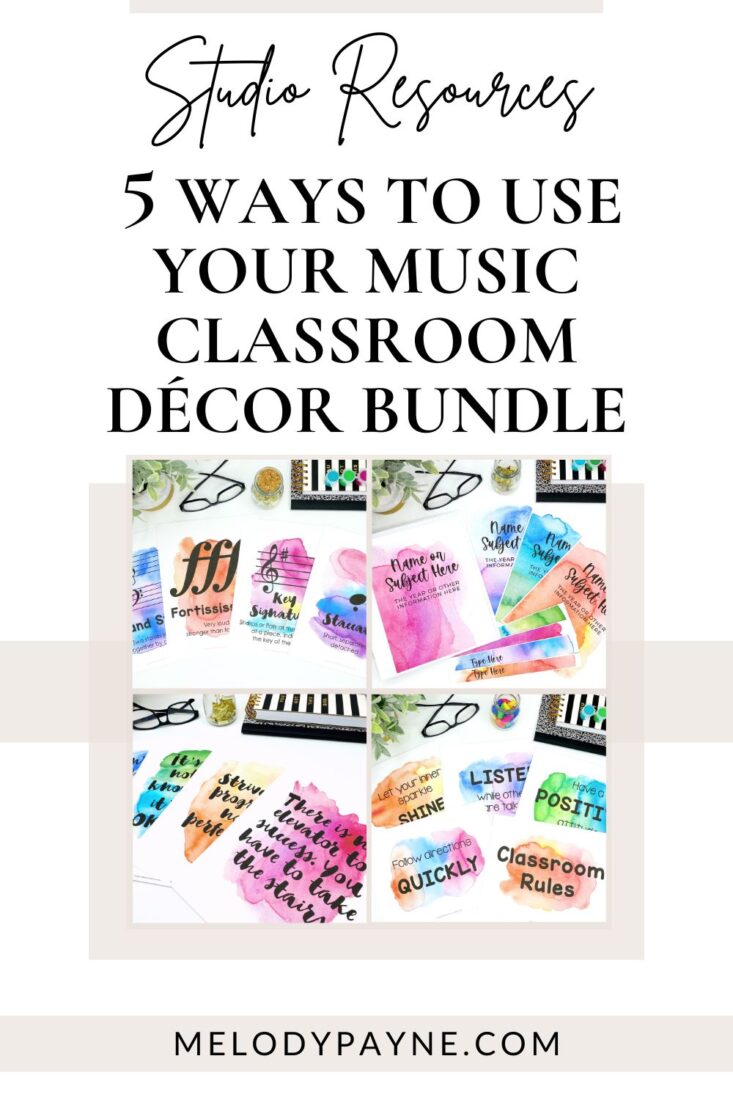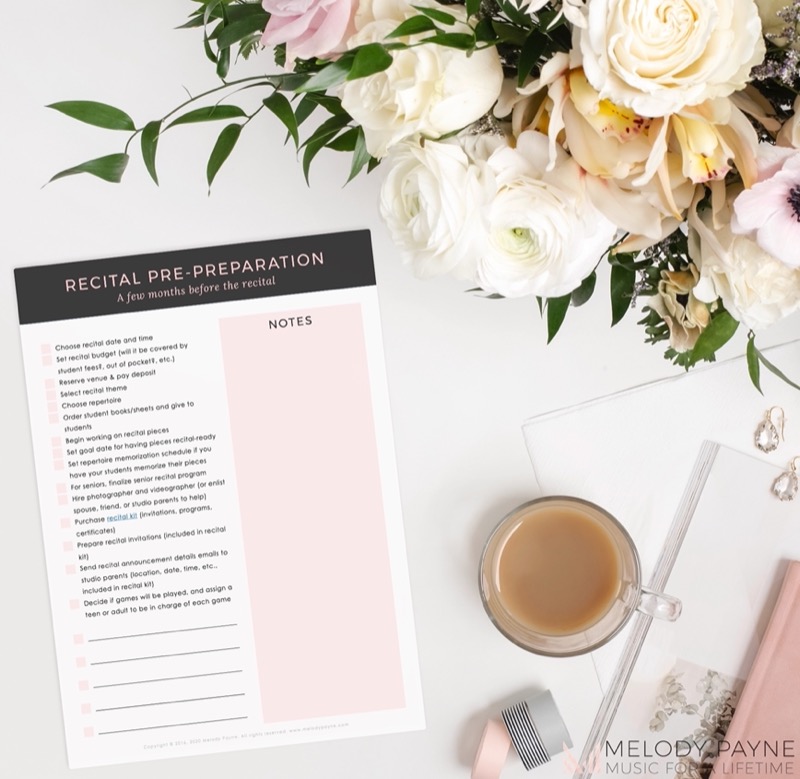3 Upper Back Exercises for Piano Teachers
This post may contain affiliate links. If you purchase something through an affiliate link, I will receive a small commission at no cost to you. For more information, read the disclosure statement here.
How often do your shoulders and upper back hurt from sitting all day teaching piano… and you do nothing about it because you don’t know where to start with upper back exercises?
Welcome to Part 2 of our Piano Teacher Wellness series, in which we’re addressing the issues that cause neck and back pain from spending hours each day participating in piano lessons.
I interviewed my physical therapist, Stephanie Elkins, DPT, to see how we can prevent these pain and posture issues with upper back exercises.
In this 4-part series, Dr. Elkins is answering my questions about the causes of “Tech Neck”, the rounded shoulders and hunched back that are part of the cause of piano student slouching.
She also shows us 3 upper back exercises that will help us strengthen the weak muscles that contribute to back and neck problems.
Additionally, she will show us how we can reverse the painful issues that stem from spending so much time sitting in front of our devices with less than ideal posture.
Did you get a chance to read Part 1 yet? Read how to Fix Piano Student Slouching With Chin Tucks.
The rest of this article is in interview format. Please enjoy this informative and enlightening question and answer session between my sister Stephanie and I.
Legal Disclaimer: This article is not intended to be medical advice. It is intended for demonstration purposes only and should not be used to self-diagnose or self-treat any condition.
Consult with your own medical professional before starting any new exercise program.
You agree to hold harmless this site and all individuals involved in the publication of this article for any damages resulting from the use or misuse of this article’s content.
Use of any content in this article is at your sole risk.
Upper Back Exercises for Piano Teachers, Part 1
Melody: In our last article, we discussed thoracic kyphosis with forward head posture, casually known as “tech neck”.
We talked about how chin tucks can reverse and even eliminate the pain that comes from the slouchy neck and back posture we often find ourselves in when we’re sitting in front of our devices.
I’ve enjoyed doing my chin tucks for the past week, and I’m looking forward to learning some new approaches this week to strengthen my piano posture!
What tips do you have for us this week, Stephanie?
Stephanie: If you recall, last week I mentioned that these slouching-related issues start with weak cervical muscles in the neck that begin to domino down the back.
This week, we’ll be addressing the upper back: the periscapular muscles.
Periscapular Muscles
Melody: I’ve noticed in several of my online piano students that they’re beginning to sit with a very curved upper back a lot more frequently.
It seems to be getting worse the more time they’re spending on their devices, including online piano lessons.
I feel like I’m constantly reminding them to “sit tall!”
Are there any upper back exercises that can help us address the root cause of those poor postures?
Stephanie: Scapular retractions (pinching or squeezing the shoulder blades together) are a wonderful and easy way to address those poor postures related to upper back weakness.
Melody: What role do the scapular retractions play in our overall piano posture?
Stephanie: Similar to the neck, when the upper back muscles fall into the rounded position, the periscapular muscles are in their relaxed and stretched position.
When piano teachers and piano students are spending hours each day on their devices, those periscapular muscles are staying in that stretched position for several hours at a time.
When they stay in that stretched position for prolonged periods of time, they become weaker and weaker.
Those weaker muscles cause the rounded shoulders, the forward flexed posture.
Sitting this way compresses the lungs and the diaphragm, which means the lungs can’t expand and relax as they should for proper air flow.
Melody: Wow, that doesn’t sound good! How can we correct this issue with the scapular retractions you mentioned, and how can that help our piano students?
Stephanie: Scapular retractions can easily be done by pinching the shoulder blades together.
Pinching the shoulder blades opens the thoracic cavity so the lungs can function the way they should.
It immediately elevates the posture, pulls the shoulders back, pulls the head back, opens the chest, and gives you that wonderful piano posture you need.
How to Perform Scapular Retractions
Stephanie: To perform scapular retractions correctly, squeeze (pinch) your shoulder blades together.
When you’re doing these upper back exercises, pretend you are trying to hold money between your shoulder blades, and if you relax them, you drop the money.
Repetitions
Do 3 sets of 10. Repeat 2-3 times a day. After a day or two, your muscles may feel a little sore from these upper back exercises, but that is normal and expected.
A special thank you to Kacee Rose, LPTA, for demonstrating the correct performance of this exercise in the following video.
Keep scrolling after you watch this video. There are more exercises and two more videos below!
Upper Back Exercises for Piano Teachers, Part 2
Melody: Are there any other upper back exercises for piano teacher you would recommend to help strengthen those muscles?
Stephanie: Our ultimate goal is to strengthen the muscles all the way around the shoulder blades.
High and low rows, similar to rowing a boat, play a similar role to the scapular squeezes.
The high rows and the low rows work the same muscles as the scapular squeezes, and the high rows are the most engaging. We’ll start with low rows.
How to Perform Low Rows
Stephanie: For low rows, keep your elbows at your sides and pull straight back while pinching your shoulder blades together.
Repetitions
Do at least 3 sets of 15. Repeat 2-3 times a day.
A special thank you to Kacee Rose, LPTA, for demonstrating the correct performance of this exercise in the following video.
Keep scrolling after you watch this video. There is another exercise and one more video below!
How to Perform High Rows
Stephanie: For the high rows, your forearms need to be parallel to the ground. You also want to create a 90 degree angle between your arms and your body as you pull your arms straight back.
Repetitions
Do at least 3 sets of 15. Repeat 2-3 times a day.
A special thank you to Kacee Rose, LPTA, for demonstrating the correct performance of this exercise in the following video.
Recommended Tools:
- Stephanie’s favorite ice pack for sore muscles
- Stephanie’s favorite Therabands for high and low rows
- Stephanie’s favorite yoga mat for chin tucks
- Melody’s favorite equipment for online piano lessons
Other resources for piano teachers
Don't miss out!
Follow us on Facebook and Instagram, join our Facebook group for piano teachers, and subscribe to the newsletter to get helpful teaching tips, resources, and tutorials delivered straight to your inbox every week.
Stephanie Elkins
Stephanie Elkins
Welcome!

Hi! I’m Melody Payne, a pianist and piano teacher, educational resource author, a fun-loving wife to the most wonderful and talented hubby I could ask for, and a lifelong learner who loves to share. I want to make your life as a music teacher easier by writing and sharing helpful and relevant music teaching articles, and by creating educational resources with your very own students in mind. If you are a parent who wants to enroll your child in piano lessons, I’d love for us to get started building those skills that can give your child a lifetime of musical enjoyment!








